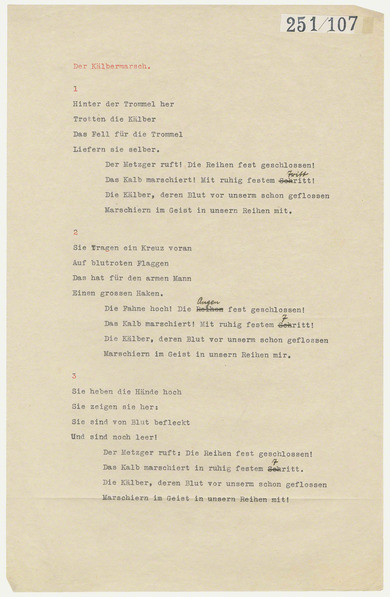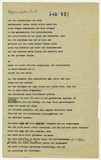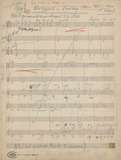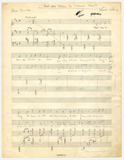Bertolt Brecht: Kaelbermarsch [March of the Calves], typescript (1943)
Hinter der Trommel her
Trotten die Kälber
Das Fell für die Trommel
Liefern sie selber.[Following the drum
The calves trot
The skin for the drum
They deliver themselves. (ed. trans.)]
Bertolt Brecht, Der Kälbermarsch, 1943
The lyricist Bertolt Brecht wrote the satirical song Kälbermarsch [March of the Calves] in September 1933, during his French exile. Later, Brecht incorporated it into his play Schweyk im Zweiten Weltkrieg [Schweyk in the Second World War], which he wrote between 1941 and 1944. It is a bitter parody of the Horst-Wessel-Lied [Horst Wessel song], which was originally a battle song of the SA, the Nazi’s paramilitary wing, and then became the official anthem of the Nazi Party. In March of the Calves, Brecht decried the unconditional obedience of the German soldiers under the Nazi regime. The soldiers are described as calves that, as a faceless group, shun personal responsibility and go to their death without challenging the dictatorship. It is likely that Brecht wrote the song for anti-fascist radio broadcasts.
Line by line, he parodies the Nazi anthem. Brecht turns “Die Fahne hoch. Die Reihen dicht geschlossen” [The flag on high. The ranks tightly closed] into: “The butcher calls. The eyes shut tight.” Brecht initially intended for the piece to be performed in New York with music by Kurt Weill, but that did not happen. Instead, in 1943 Hanns Eisler, who had previously collaborated with Brecht on several occasions, contributed the music for Brecht’s play. The two knew each other from when they worked together on Die Maßnahme(1929) [The Measures Taken]. Eisler wrote the music in exile in Hollywood. The play was performed for the first time in Warsaw in 1957.





